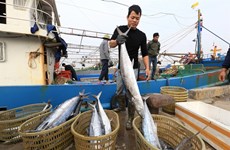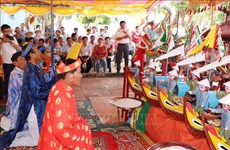Visitors seek vanishing beauty of Con Dao
Mother Nature has been unduly kind to Con Dao, even if mankind hasn't.
Mother Nature has been unduly kind to Con Dao, even if mankind hasn't.
The archipelago epitomises picture-postcard prettiness – soft white sand, aquamarine seas, virgin mangrove forests, coral reefs to die for, real-life mermaids that sing like sea nymphs. The superlatives go on and on.
There are few places in the 21st century that can rival Con Dao's pristine beauty. And as you look out on all this splendour, it's hard to imagine that it was once a French penal colony and an American prisoner-of-war camp.
"It's a real heaven on earth, something that I thought could only exist in my dreams," says Vu Minh Huyen, a tourist from Hanoi .
The 16-island archipelago lies in sublime loveliness 180km south of Vung Tau City – at the moment at least. The nation now wishes to exploit its natural charms, which is why Belgian engineer Stijn Verdickt fears for its future.
"Go before it's too late," he warns.
The 10-year Con Dao development master plan is expected to be given the nod of approval by Prime Minister Nguyen Tan Dung later this year.
In fact, beach-view land plots on Con Son, the only inhabited island in the archipelago, have already been sold, says Bui Van Binh, deputy chairman of the district's People's Committee.
"As soon as the master plan is approved, construction will start on a massive scale," he says.
Binh admits that developing Con Dao while preserving its natural beauty and breathtaking biodiversity is a "paradox" – a really tough job.
But development will come, says Dao Xuan Lai, head of the UNDP Sustainable Development Department in Vietnam . But he is hopeful it will be done with discernment.
"Development and preservation are not necessarily opposing forces," he says.
Preserving the island is to attract tourists to boost the incomes of the local people and ensure sustainable growth and ensure sustainable growth, he says.
Preservation of the archipelago has been given top priority under the National Action Plan on Biodiversity and National Global Environment Facility over the past 15 years.
Con Dao became a national park in 1993 – only one of four officially protected areas in Vietnam to include both terrestrial and marine values.
Con Dao is home to the biggest population of sea turtles in Vietnam . Among those are the endangered green and hawksbill species. Park director Le Xuan Ai says about 350 mother turtles come to Con Dao to lay eggs each year and that about 50,000 baby turtles hatch and make their way to the sea.
The islanders also cherish the dugongs, the so-called "singing mermaids". At least 10 can be found serenading off-shore.
The 20-ha national park is also home to more than 40 other endangered species that are named in the International Union for Conservation of Nature's Red List and Vietnam 's Red Book.
Fringing the archipelago is about 7,000ha of coral reef. About 300 species of coral have been counted and coral fish has the highest density recorded off the coast of Vietnam .
Former Deputy Prime Minister Vu Khoan likens Con Dao to a blank sheet of paper "on which we should carefully draw".
The archipelago, where the French built tiger cages to hold political prisoners nearly 150 years ago, has drawn special attentions from the Government and the Party. In fact, such is the importance given to the archipelago that development can only proceed with prime ministerial approval – a rare distinction.
However, development on Con Dao has been slow and small-scale, something that Ai says is ‘lucky".
"Great care and consideration have been paid to development of the archipelago so that it proceeds in the right direction," he says.
Binh says an important milestone was made in 2005 when then Prime Minister Phan Van Khai approved the Con Dao Socio-economic Development Plan, which would have come to full fruition in 2020.
The strategy, known as "Plan 264", has "completely changed direction of Con Dao's development in a much more sustainable way," says Ha Van Nghia, deputy director of the province's Agriculture and Rural Development Department in.
Plan 264 dictates that development of Con Dao should only focus on sustainable tourism services on the basis of the archipelago's preserved historic relics and protected national park, which accounts for 83 per cent of the land area.
The first plan, signed by former Prime Minister Vo Van Kiet in 1997, mistakenly stated that development should be "multifaceted and comprehensive".
Ai says Kiet himself then admitted that if it had been carried out, Con Dao would have been destroyed.
However, Plan 264, the second development proposal, remains a far cry from a report by the UNDP. The plan aims to raise the archipelago's current population of 6,700 to 50,000 and attract 500,000-700,000 tourists annually by 2020. About 30,000-50,000 tourists now visit Con Dao each year.
The UN's Coastal and Marine Biodiversity Conservation and Sustainable Use in Con Dao project however states that these targets are well beyond the archipelago's carrying capacity. "The natural ecological systems on the archipelago are very sensitive to human interference. Thus every distortion and interference beyond its capacity will result in major disruption. Con Dao's attractive green and natural appearance will be lost," Ai says bluntly.
The third master plan is currently being considered by the Prime Minister. It has revised down these targets to 20,000 residents and no more than 500,000 tourists a year, Nghia says.
It also prohibits industries, such as aquatic product processing, which can harm the archipelago's marine environment. Any development will have to be environmentally friendly and in keeping with the islands' marine and terrestrial ecology.
The new plan has the support of Nguyen Thi Hong Xinh, the former deputy chairwoman of the provincial People's Council. "It is a positive development and a reflection of the progress in official sensitivity," she says.
Ai, however, says there is no room for complacency.
"Good evaluation of any planned investment projects is crucial to Con Dao's sustainable development," says Ai, who has spent 25 years, half his life, fighting to preserve the archipelago's natural beauty.
He is not alone. Watching from their resting places are late heroine Vo Thi Sau and former Party leader Le Hong Phong, whose love for Con Dao lives on./.
The archipelago epitomises picture-postcard prettiness – soft white sand, aquamarine seas, virgin mangrove forests, coral reefs to die for, real-life mermaids that sing like sea nymphs. The superlatives go on and on.
There are few places in the 21st century that can rival Con Dao's pristine beauty. And as you look out on all this splendour, it's hard to imagine that it was once a French penal colony and an American prisoner-of-war camp.
"It's a real heaven on earth, something that I thought could only exist in my dreams," says Vu Minh Huyen, a tourist from Hanoi .
The 16-island archipelago lies in sublime loveliness 180km south of Vung Tau City – at the moment at least. The nation now wishes to exploit its natural charms, which is why Belgian engineer Stijn Verdickt fears for its future.
"Go before it's too late," he warns.
The 10-year Con Dao development master plan is expected to be given the nod of approval by Prime Minister Nguyen Tan Dung later this year.
In fact, beach-view land plots on Con Son, the only inhabited island in the archipelago, have already been sold, says Bui Van Binh, deputy chairman of the district's People's Committee.
"As soon as the master plan is approved, construction will start on a massive scale," he says.
Binh admits that developing Con Dao while preserving its natural beauty and breathtaking biodiversity is a "paradox" – a really tough job.
But development will come, says Dao Xuan Lai, head of the UNDP Sustainable Development Department in Vietnam . But he is hopeful it will be done with discernment.
"Development and preservation are not necessarily opposing forces," he says.
Preserving the island is to attract tourists to boost the incomes of the local people and ensure sustainable growth and ensure sustainable growth, he says.
Preservation of the archipelago has been given top priority under the National Action Plan on Biodiversity and National Global Environment Facility over the past 15 years.
Con Dao became a national park in 1993 – only one of four officially protected areas in Vietnam to include both terrestrial and marine values.
Con Dao is home to the biggest population of sea turtles in Vietnam . Among those are the endangered green and hawksbill species. Park director Le Xuan Ai says about 350 mother turtles come to Con Dao to lay eggs each year and that about 50,000 baby turtles hatch and make their way to the sea.
The islanders also cherish the dugongs, the so-called "singing mermaids". At least 10 can be found serenading off-shore.
The 20-ha national park is also home to more than 40 other endangered species that are named in the International Union for Conservation of Nature's Red List and Vietnam 's Red Book.
Fringing the archipelago is about 7,000ha of coral reef. About 300 species of coral have been counted and coral fish has the highest density recorded off the coast of Vietnam .
Former Deputy Prime Minister Vu Khoan likens Con Dao to a blank sheet of paper "on which we should carefully draw".
The archipelago, where the French built tiger cages to hold political prisoners nearly 150 years ago, has drawn special attentions from the Government and the Party. In fact, such is the importance given to the archipelago that development can only proceed with prime ministerial approval – a rare distinction.
However, development on Con Dao has been slow and small-scale, something that Ai says is ‘lucky".
"Great care and consideration have been paid to development of the archipelago so that it proceeds in the right direction," he says.
Binh says an important milestone was made in 2005 when then Prime Minister Phan Van Khai approved the Con Dao Socio-economic Development Plan, which would have come to full fruition in 2020.
The strategy, known as "Plan 264", has "completely changed direction of Con Dao's development in a much more sustainable way," says Ha Van Nghia, deputy director of the province's Agriculture and Rural Development Department in.
Plan 264 dictates that development of Con Dao should only focus on sustainable tourism services on the basis of the archipelago's preserved historic relics and protected national park, which accounts for 83 per cent of the land area.
The first plan, signed by former Prime Minister Vo Van Kiet in 1997, mistakenly stated that development should be "multifaceted and comprehensive".
Ai says Kiet himself then admitted that if it had been carried out, Con Dao would have been destroyed.
However, Plan 264, the second development proposal, remains a far cry from a report by the UNDP. The plan aims to raise the archipelago's current population of 6,700 to 50,000 and attract 500,000-700,000 tourists annually by 2020. About 30,000-50,000 tourists now visit Con Dao each year.
The UN's Coastal and Marine Biodiversity Conservation and Sustainable Use in Con Dao project however states that these targets are well beyond the archipelago's carrying capacity. "The natural ecological systems on the archipelago are very sensitive to human interference. Thus every distortion and interference beyond its capacity will result in major disruption. Con Dao's attractive green and natural appearance will be lost," Ai says bluntly.
The third master plan is currently being considered by the Prime Minister. It has revised down these targets to 20,000 residents and no more than 500,000 tourists a year, Nghia says.
It also prohibits industries, such as aquatic product processing, which can harm the archipelago's marine environment. Any development will have to be environmentally friendly and in keeping with the islands' marine and terrestrial ecology.
The new plan has the support of Nguyen Thi Hong Xinh, the former deputy chairwoman of the provincial People's Council. "It is a positive development and a reflection of the progress in official sensitivity," she says.
Ai, however, says there is no room for complacency.
"Good evaluation of any planned investment projects is crucial to Con Dao's sustainable development," says Ai, who has spent 25 years, half his life, fighting to preserve the archipelago's natural beauty.
He is not alone. Watching from their resting places are late heroine Vo Thi Sau and former Party leader Le Hong Phong, whose love for Con Dao lives on./.













